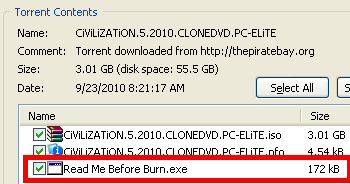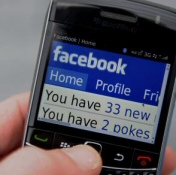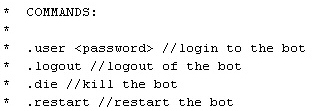
by Blog Staff | Sep 27, 2010 | Threat Lab












 It’s been more than a week that we at Webroot, and countless others, have been getting floods of bogus messages with HTML attachments. I thought I’d give the curious readers of this blog a quick glance at one of the drive-by sites that load in the browser if you try to open the file.
It’s been more than a week that we at Webroot, and countless others, have been getting floods of bogus messages with HTML attachments. I thought I’d give the curious readers of this blog a quick glance at one of the drive-by sites that load in the browser if you try to open the file.
As I’d mentioned previously, the HTML files themselves simply contain highly obfuscated Javascript (code that’s hard for humans to read but easy for machines to interpret). When you try to load those malicious scripts into a browser, the script instructs the browser to load a page from another Web site. In fact, the file I saw today goes to server 1, which bounces the browser to server 2, and then a script on server 2 loads more files from servers 3 & 4 in a full-screen iFrame.
In the end, what I saw looked like an update to what has become the “classic” Javascript fakealert. Unfortunately for the malware distributors, this so-called update is laughably obvious. These are clearly not the sharpest tacks in the box.

It all starts with a warning popup which reads:
There is a big chance that your computer is infected! They can cause data loss and file damages and need to be fixed as soon as possible. Return to Microsoft Security Assessment Tool and download it to guard your PC.
Wow, really? How big is the chance? Is this more like a scratch-off lottery ticket level of chance, or is it closer to a look under the bottle cap to see if you win chance? What they don’t tell you is that your chance of becoming infected with an annoying rogue increases to about 100% if you continue down this well-worn path. (more…)

by Blog Staff | Sep 25, 2010 | Threat Lab












 Bootlegged copies of Civilization 5, the highly anticipated, just-released real time strategy game, are already popping up in file sharing services. And, as we’ve come to expect, some of the pirated copies of the game come with that little something special — malicious components.
Bootlegged copies of Civilization 5, the highly anticipated, just-released real time strategy game, are already popping up in file sharing services. And, as we’ve come to expect, some of the pirated copies of the game come with that little something special — malicious components.
One of our Threat Research Analysts, who also happens to be an avid gamer, started looking for pirated copies of the game Friday morning and, within five minutes of looking, found Trojans in some of the torrents in circulation. I’ve chosen to focus on one of these files, not only because it was the first we saw, but also the most interesting. The Trojan, bundled in a torrent with the ISO image of the Civ 5 installation disc, is called ‘read me before burn.exe‘ (MD5: 2f7ff2ecef4b5cf1c9679f79d9b72518).
On a typical Windows system, the file appears to be a text document, but only because it uses a file icon of a text document. With the file extension visible, however, it’s clearly an .exe with a mission.
(more…)

by Blog Staff | Sep 22, 2010 | Threat Lab












 If you hadn’t already noticed, an ongoing spam campaign where someone is sending email messages with attached HTML files continues to be a problem. The current campaign appears to be a new wave of spam similar to the one I reported about in July.
If you hadn’t already noticed, an ongoing spam campaign where someone is sending email messages with attached HTML files continues to be a problem. The current campaign appears to be a new wave of spam similar to the one I reported about in July.
The messages, which began arriving a week ago, have subject lines pulled from news headlines (“Cops kill shooter at Johns Hopkins Hospital,” “America’s Got Talent Judges Were They Shocked,” “Daniel Covington”) and with a financial angle (“Apartment for rent,” “Invoice for Floor replacement,” “credit card,” and the ever-popular “Shipping Notification”).
The messages themselves are brief, such as the one shown above, and encourage the recipient to open the attached file.
Several readers have already sent me messages complaining about the volume, and asking what to do about the spam. My answer is the same with these spam messages as with any other spam messages: Delete them, mark them as spam, or do whatever you can to train your email spam filter to learn and block those messages.
One thing you should not do is open the HTML file.
(more…)

by Blog Staff | Sep 21, 2010 | Threat Lab












 In the world of first-person shooter games, getting the most headshots — hits on the opponent which instantly take the opponent’s avatar out of the game — is a prized goal. The headshot is the quickest way to dispatch a foe in virtually every shooter, which is why the file name of a malware sample, currently in circulation, stood out.
In the world of first-person shooter games, getting the most headshots — hits on the opponent which instantly take the opponent’s avatar out of the game — is a prized goal. The headshot is the quickest way to dispatch a foe in virtually every shooter, which is why the file name of a malware sample, currently in circulation, stood out.
The file, yogetheadshot.php.exe (VT), is a dropper, a glorified bucket designed to tip over and spill other malware all over a PC. But where other droppers might leave behind a handful of payloads, this one utterly decimated a testbed PC with a malware headshot — an unusually overt infection that, defying conventional wisdom about malware infections, took no apparent effort to mask its behavior or remain low key.
The file, extracted from network traffic recorded while a test system got manhandled by a drive-by download site, was only one of several executable payloads that originated from the same domain hosting the drive-by.
But this sole dropper was more than capable of delivering the terminal blow to a middle aged Windows XP box. We first saw it appear on September 7th, but it has become more widespread since then.
(Update, 22 Sept.: Here’s a video that shows what happens on a system when someone executes this dropper. The dropper is near the upper-left corner of the screen. The rest of the screen is taken up with Process Explorer, which lets you see just how many payloads the dropper delivers.)
[vimeo 15167753]
(more…)

by Blog Staff | Sep 16, 2010 | Threat Lab












 For years, the makers of those snake oil security programs we call Rogue Security Products have spent considerable effort making up new names, developing unique graphic design standards, and inventing backstories for their utterly useless, expensive scam products. Now a new rogue has taken this never ending shell game one step further, releasing a single program that calls itself one of five different names, depending on what button an unfortunate victim clicks in a highly deceptive dialog box. Let’s call it what it really is, though: A malicious play in five acts.
For years, the makers of those snake oil security programs we call Rogue Security Products have spent considerable effort making up new names, developing unique graphic design standards, and inventing backstories for their utterly useless, expensive scam products. Now a new rogue has taken this never ending shell game one step further, releasing a single program that calls itself one of five different names, depending on what button an unfortunate victim clicks in a highly deceptive dialog box. Let’s call it what it really is, though: A malicious play in five acts.
The rogue’s delivery method, or Act 1 in this melodrama, is no different from the many we’ve seen in the past 18 months which use a Javascript-enhanced Web page to convince viewers they’re watching a live malware scan on their computer. This trick is so hackneyed, it’s become the cybercrime equivalent of the dastardly villain in a silent movie tying the hapless woman to a railroad track, then twisting the ends of his mustache for dramatic effect. Does anyone still fall for this?
Only, this time the fakealert delivers a different payload: When the victim runs the rogue executable (named simply setup.exe), Act 2 begins. The rogue displays a dialog box that looks like an alert message issued by Microsoft Security Essentials, cautioning the victim that a legitimate Windows component present on most or all installations of Windows, such as iexplore.exe or cmd.exe, is actually a piece of malware.
The rogue helpfully offers to perform some sort of online scan, and that’s where it gets weird. The rogue pretends to scan the hard drive with 32 different antivirus engines, a-la VirusTotal. The vast majority of them are well known, at least in the security community. But five are new, and it’s those five that merit closer inspection.
(more…)

by Blog Staff | Sep 14, 2010 | Threat Lab
By Ian Moyse, EMEA Channel Director












 Hardly a week goes by when the national press doesn’t carry a story about how social networks represent a threat to privacy or security, or both. These news stories aren’t wrong: Users of social networks face a raft of risks, ranging from malware attacks and identity theft, to cyberbullying, grooming from sexual predators or stalkers, viewing or posting inappropriate content, and the ever-present risk that you (or someone you work with) might end up with your foot (or is it your keyboard?) firmly in mouth.
Hardly a week goes by when the national press doesn’t carry a story about how social networks represent a threat to privacy or security, or both. These news stories aren’t wrong: Users of social networks face a raft of risks, ranging from malware attacks and identity theft, to cyberbullying, grooming from sexual predators or stalkers, viewing or posting inappropriate content, and the ever-present risk that you (or someone you work with) might end up with your foot (or is it your keyboard?) firmly in mouth.
Using social networks to give out too much information about yourself can also lead to some predictably poor outcomes. One Australian employee, fired from his job, had posted about skiving from work after a night of heavy drinking. A group of call center employees swapped brags about abusing customer information on Facebook and were fired. Is it hard to believe that the employer used the employees’ own Facebook posts as a virtual admission of guilt?
With Facebook adding over 400,000 users a day and LinkedIn 400,000 a week, social networks can no longer be ignored by employers, as employee misuse of social networks accelerate.
(more…)

by Blog Staff | Sep 10, 2010 | Threat Lab












 In what seems to be a trend in my September blog posts, the research team has run across a program meant for criminally-minded people which has a nasty surprise inside.
In what seems to be a trend in my September blog posts, the research team has run across a program meant for criminally-minded people which has a nasty surprise inside.
The program in question is called the ZombieM Bot Builder, which is used by the kind of upstanding citizens who spread Trojans in order to build up botnets — a collective of infected computers that can act as one entity. The creators of this program, an Argentinian group called Arhack, sell it for 180 euros. But don’t pull out your stolen credit cards just yet, because Arhack doesn’t take Visa: They sell this garbage exclusively via Western Union money transfer.
 Well, someone has cracked both the earlier, 1.0 version of their bot generator and the latest, 2.0 version, and posted it online for other criminals — the cheap kind, who don’t have 180 euros to spare — to use. The cracked version lets you use all aspects of the program to generate bots and manage the botnet without the need for a customized username and password, which you would otherwise need in order to start up the program.
Well, someone has cracked both the earlier, 1.0 version of their bot generator and the latest, 2.0 version, and posted it online for other criminals — the cheap kind, who don’t have 180 euros to spare — to use. The cracked version lets you use all aspects of the program to generate bots and manage the botnet without the need for a customized username and password, which you would otherwise need in order to start up the program.
But there’s a hitch: Whenever you run the cracked version, it also installs Trojan-Backdoor-PoisonIvy, a different but equally nasty botnet Trojan. The backstabbing Trojan trifecta is in play.
(more…)

by Blog Staff | Sep 7, 2010 | Threat Lab












 If you live in the US, you may have played sports, barbequed, or enjoyed the last long weekend of the summer outside doing something fun outdoors. Unfortunately, that wasn’t an option here in Boulder, where a large wildfire generated a thick plume of smoke and ash. So, what’s a malware analyst to do indoors on a beautiful day with toxic smoke outside? Why, spend some quality time with Koobface, of course.
If you live in the US, you may have played sports, barbequed, or enjoyed the last long weekend of the summer outside doing something fun outdoors. Unfortunately, that wasn’t an option here in Boulder, where a large wildfire generated a thick plume of smoke and ash. So, what’s a malware analyst to do indoors on a beautiful day with toxic smoke outside? Why, spend some quality time with Koobface, of course.
I took a closer look at the worm’s behavior and also noted that, since the Migdal keylogger site went dark for the Koobface crew, they’ve switched to using a new domain as the dead drop for credentials stolen by the Koobface password stealer payload: m24.in, the Web site of some sort of media company based in India. The behavior I saw by the keylogger was virtually identical to that used by the Migdal variant, reported in a previous post. The payload is even named m24.in.exe, just like the Migdal payload was named after the domain where it posted stolen passwords.

It’s been a while since the worm changed its primary method of infection: For nearly its entire existence, Koobface has spread by manipulating the social network accounts of infected users so it appears the user posted a link to a video. Of course, the worm does the posting in the name of the user, and the link points to a page which purports to be some sort of streaming video, but actually pushes the malware on anyone who visits.
And, in order to take on the appearance of a real online video, it uses Flash.
(more…)

by Blog Staff | Sep 6, 2010 | Threat Lab












 Is there no honor among thieves anymore?
Is there no honor among thieves anymore?
The other day I was looking at a remote access Trojan written in the PHP scripting language. The bot loads into memory on a victim’s computer when an unsuspecting user, for example, stumbles upon an iframe pointing to the PHP script embedded in a Web page. The code is nicely appointed with such desirable features as the ability to execute shell commands on the host server, send a flood of data packets at another computer, and scan remote computers.
Once loaded into a victim’s browser, the bot connects to, and is capable of executing commands issued by, a botnet server–until the victim reboots their computer. But for most users, that’s probably long enough. If an attacker can execute commands on an infected user’s computer, installing more Trojans is just child’s play.
But someone appears to have embedded a surprise into this PHP backdoor: It’s another backdoor within the backdoor.
(more…)

by Blog Staff | Sep 2, 2010 | Threat Lab












 Is the team behind the Koobface worm taking a stance on the Israeli-Palestinian peace talks, or is this notorious worm’s most recent, bizarre twist just a coincidence?
Is the team behind the Koobface worm taking a stance on the Israeli-Palestinian peace talks, or is this notorious worm’s most recent, bizarre twist just a coincidence?
We’ve seen Koobface hijack legitimate Web sites for more than a year, using them not only to host malicious payload files, but also to work as proxy command-and-control servers for the botnet. One such hijacked Web domain, migdal.org.il, popped up in a number of blog posts and on Web sites which list the domains used to host malware, as far back as this past May, when the Koobface crew began using a slew of new hijacked servers as distribution points for its malicious files.
And since the summer, Koobface has been delivering a password stealing Trojan among the several payloads it brings down to an infected computer. That Trojan’s name is migdal.org.il.exe, and the stolen passwords it scrapes from infected computers are sent right back to the migdal.org.il Web server, which is physically located at an ISP in the UK.
Migdal also seems to be (if you can believe the content posted to the Web site) a French jewish organization that provides aid and resources to Israeli children and border guards, and whose leadership opposes many of the Israeli concessions that Palestinian negotiators have requested during the long peace process. Have the Koobface gang gone political, or are they just capitalizing on a convenient situation with an abandoned Web site?
(Update: The site went down on September 3rd, the day after this post went live. Thanks, helpful ISP who shall remain nameless.)
(more…)

 It’s been more than a week that we at Webroot, and countless others, have been getting floods of bogus messages with HTML attachments. I thought I’d give the curious readers of this blog a quick glance at one of the drive-by sites that load in the browser if you try to open the file.
It’s been more than a week that we at Webroot, and countless others, have been getting floods of bogus messages with HTML attachments. I thought I’d give the curious readers of this blog a quick glance at one of the drive-by sites that load in the browser if you try to open the file.
























































































